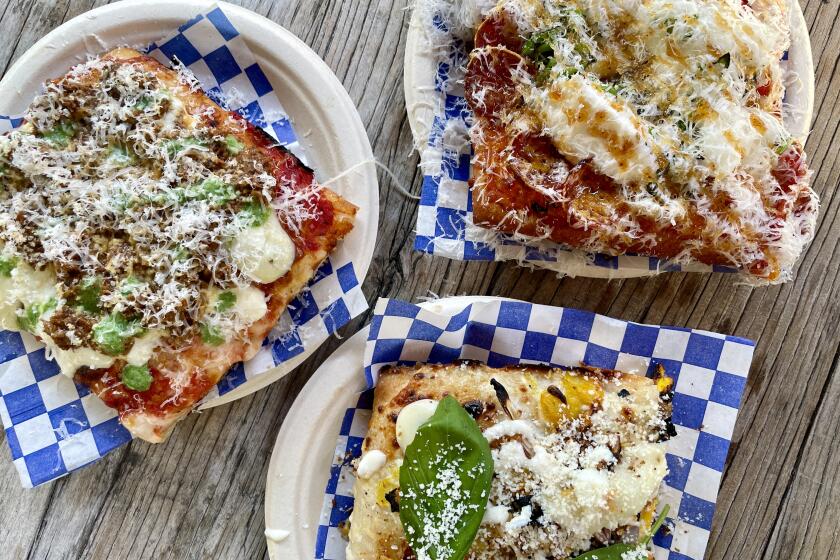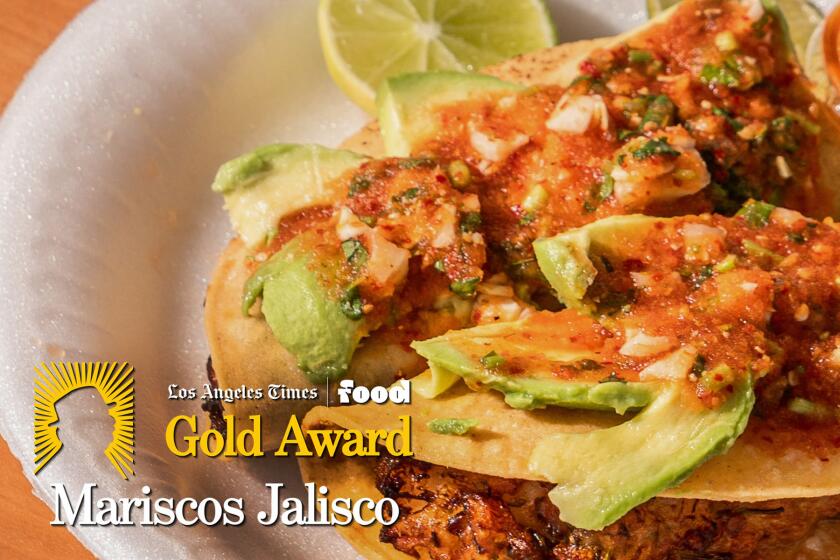Profits Pouring In for Sierra Vintners
Houston wine lover Ron Nichely is so partial to Boeger Winery’s offerings that family visits to nearby Stockton find him cramming his luggage with bottles. His “personal best”: two cases of wine into one bulging suitcase.
But on Monday, Nichely tried something new. He simply called the small winery and ordered a case of its well-regarded Tempranillo for $14 a bottle, aided by a recent U.S. Supreme Court decision and a change in Texas law allowing consumers to buy directly from out-of-state wineries.
“I prefer to get all my wines direct from the winery,” said Nichely, an engineer in the oil industry. “That way I know how it was stored and when it was shipped.”
That’s what vintner Greg Boeger likes to hear.
Boeger makes as much profit in a single direct sale as he does peddling two bottles of wine through a distributor. By keeping his tasting room open late on Fridays in the summer, aggressively pitching his wine club and direct shipments, Boeger is now moving 56% of the 18,000 cases of wine he makes each year straight to consumers.
“More direct sales is what this is all about,” Boeger said, describing a business model that is typical among the 700 California wineries selling 5,000 or fewer cases of wine annually.
That strategy has turned into an art form here in the Sierra foothills, an area known for its scorching summer temperatures and the abandoned gold mines and historic markers that seem to dot every other mile of Highway 49, which runs like a spine through the wine-making region that includes Amador, Calaveras and El Dorado counties. It is about the last corner of wine country where oenophiles can wander into a tasting room, meet the winemaker and sample the vintages without paying a fee.
“If you can sell every drop of what you make out to the tasting-room door, through your wine club or by direct shipping, you will be king,” said Scott Klann, winemaker at Twisted Oak Winery, a small producer in the Calaveras County hamlet of Vallecito.
Thanks in part to the U.S. Supreme Court ruling in May, wineries such as Boeger and Twisted Oak are getting a better shot at wine lovers. The court struck down New York and Michigan laws that let local wineries ship directly to the public but prohibited out-of-state vintners from doing the same.
The ruling has led to a liberalization of wine shipping laws in New York, Connecticut and several other large markets, allowing small wineries to make an end run around distributors.
All told, 30 states, accounting for 68% of the nation’s $23-billion retail wine market, now allow individuals to place orders with wineries. That’s up from 26 states, or about 50% of the market, at the start of the year, according to Free the Grapes, a Napa-based wine-shipping advocacy group.
Already, the Sierra foothills wineries are seeing an increase in business from the gradual liberalization of the shipping rules.
Boeger Winery is on track to ship $65,000 worth of wine to out-of-state consumers this year, 30% ahead of last year.
Shipping companies such as FedEx Corp. are starting to supply small wineries with marketing materials such as “Swirl, Sniff, Sip and Ship!” signs to remind tasting-room visitors that they can probably send any purchases home. But increasing direct sales isn’t as simple as just taking down someone’s credit card number.
Distributors don’t want to lose market share -- even a small amount -- to the small wineries pursuing the direct-sales strategy, said Barbara Insel, managing director for research at MKF Group, a St. Helena, Calif., wine consulting firm. They have used their political clout to get complicated compliance procedures written into legislation by states legalizing wine shipments to consumers.
“There’s all sorts of paperwork, the wineries have to collect and keep track of taxes, they have to keep statistics on how much they ship to a customer, and in some states they are going to have to buy special permits that won’t be worth the cost unless they are selling a lot of wine there,” Insel said. “But if they can conquer those hurdles, this is going to mean a lot of money to a lot of people.”
Wine industry analysts believe that direct consumer sales through wine clubs, tasting rooms and phone and Internet orders account for as much as 3% of California’s $15-billion wine industry.
At least 65% of sales at small wineries in the Sierra foothills are direct to consumers, Insel estimated.
Finding ways to bypass the wholesale channel is especially important to the wineries in the Sierra foothills, where vintners can’t slap Napa or Sonoma on their label and expect the wine to sell.
Even Ironstone Vineyards, which sells nearly 1 million cases a year and is the region’s biggest winemaker, is still dependent on the business it does at its 1,100-acre winery complex in Murphys in Calaveras County. Ironstone uses non-wine amenities to make itself a tourist destination, including a 3,500-seat amphitheater for concerts, a restaurant, a stream for gold panning and a small mining museum that displays a 44-pound gold nugget.
On a typical Saturday, 800 or more tourists meander through the complex, said Stephen Kautz, Ironstone’s president, and “at least half walk out of here with two bottles of wine.” About 25% of the family-owned wine company’s profit is generated at the site, he said.
For decades, the Sierra foothills have been a backwater of the state’s wine industry. California’s reputation as one of the world’s great wine regions was made in the Napa Valley and then grown along the coast in such places as Healdsburg in Sonoma County south to the Santa Rita Hills in Santa Barbara County.
When Charles Krug and the Beringer brothers started to develop Napa Valley’s wine industry 150 years ago, this is where Mark Twain lived in a wood cabin on Jackass Hill and hung out in an Angels Camp saloon, taking notes for “The Celebrated Jumping Frog of Calaveras County,” the story that catapulted him to national fame.
Boeger was one of the first vintners to scout the Sierra foothills. A scion of Napa’s Nichelini winemaking clan, Boeger purchased a 110-acre pear farm in Placerville, in El Dorado County, for $70,000 in 1972.
“I was just out of UC Davis and couldn’t afford to buy land in Napa,” he said.
The region has many of the characteristics that make for good vineyard land. There is a mix of volcanic and shale soils, which makes the vines struggle for growth and produces berries with concentrated flavors.
“The proximity to the mountains makes for cool nights that are comparable to the coastal regions,” Boeger said.
His was the first post-Prohibition commercial winery in the area. Now there are at least 100.
Jeff Stai, a former electrical engineer at Aliso Viejo-based QLogic Corp., bailed out of the tech industry in 2002 and purchased 120 acres off of Highway 4 in Calaveras County for $650,000. He sank several million dollars more into the property, excavating a 300-foot cave for aging wine, building a four-level gravity-flow winery and planting vineyards.
“This was a wine region that was poised to happen,” Stai said. “The other areas get more press ... but we are starting to get more tourists and more people from the Central Valley, and we can make some pretty good wines up here.”
Stai’s winery, Twisted Oak, produces Rhone and Spanish varietals -- Rousanne, Marsanne, Mourvedre, Tempranillo and Grenache -- that do well in that climate, and stays away from the standard Cabernet Sauvignon, Merlot and Chardonnay varieties that are the bread and butter of the coastal wine trade.
The winery made 6,000 cases of wine last year, and 70% was sold directly to consumers through mail order, the winery and a nearby tasting room in Murphys.
It would be almost impossible for Twisted Oak and the other small wineries of the region to make money if they had to move every bottle of wine through a distributor, said winemaker Klann.
And that would be unfortunate for a wine industry where consolidation has placed nearly 84% of the state’s wine production in the hands of just 10 companies that sell mostly the standard Cabernet, Merlot and Chardonnay wines, vintners in the foothills say.
“Smaller wineries,” Klann said, “are where the cutting edge of the wine industry is coming from.”
More to Read
Eat your way across L.A.
Get our weekly Tasting Notes newsletter for reviews, news and more.
You may occasionally receive promotional content from the Los Angeles Times.








